19 Types of Drill Bits You Need to Have in Your Toolbox
Author: Omar Alonso | Editor: Omar Alonso
Review & Research: Jen Worst & Chris Miller

Whether you are a professional or a DIYer, a drill is an essential tool in a craftsperson’s repertoire and different types of drill bits are equally important elements that you just cannot do without.
Right from hanging pictures to fixing the roof frame, it is extremely important to use the right drill bit types for the job you are attempting to do.
Bits are made of different materials and suit varying purposes and using the proper one for a job helps to enhance your efficiency, reduce mistakes, and even accidents.
There are loads of different drill bits out there and you need to find the one that is the perfect fit for your job. So, read on to know more about the different types of drill bits.
19 Types of Drill Bits
Believe it or not, the first drill and bit we know about was the bore drill used in Egypt around 3,000 BC. These bits are in no particular order and vary in their own construction, the type of material they're meant to work with, and even their core purposes. Make sure to familiarize yourself with the various drill bit styles, because knowing what's possible is half the battle.
Twist Drill Bits
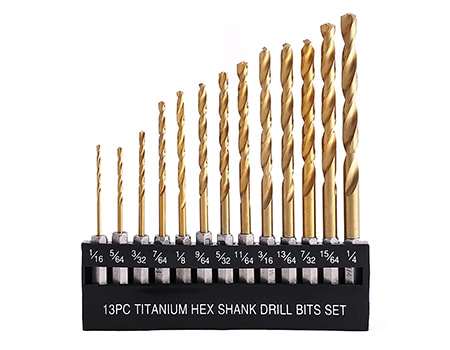
Resembling corkscrews, twist drill bits are also known as HSS (high speed) drill bits. These are the most common types of drill bits and are used to drill small holes into walls, metal, wood and plastic.
The spiral pattern on the drill bit allows them to drill and remove the debris from the hole that they make in the material. Twist drill bits are usually made from carbon steel or high-speed steel.
While high-speed drill bits are good for drilling into varying materials and also can withstand high temperatures, carbon steel bits are ideal for drilling wood, but not very good for metals because they are quite brittle and flex more compared to high-speed bits.
Brad Point Drill Bits
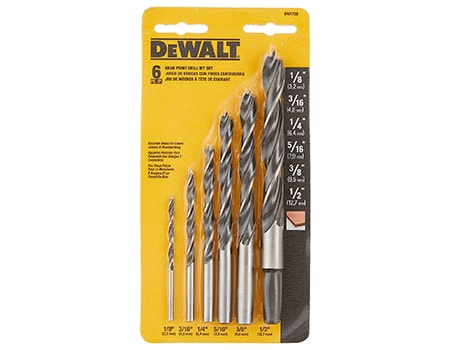
A brad point drill bit is sometimes referred to as a spur point. It's similar to a twist bit with the key difference being that the tip is shaped like the letter W in such a way that the outer circumference of the hole on the material starts being removed first.
It may be harder to start an accurate hole, but once you do you'll meet much less resistance. You can pick these up between 3 millimeters and 10 millimeters in diameter.
You'll do best to stick to using these on wood and plastic, and take advantage of the depth stop so you can move fast, because these bits can fly.
Screwdriver Drill Bits
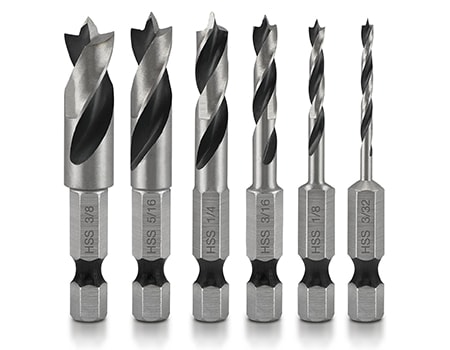
Screwdriver bits have a hex shank, fit most types of drills and are perfect for drilling holes. Depending on the type of tip, screwdriver bits can be used to drill holes in several materials.
They are ideal for use with impact drivers and handheld drills and useful for machine work, renovation and building projects. We're not talking about the ones for use with the different types of screw heads, but ones for creating holes.
Rivet Drill Bits
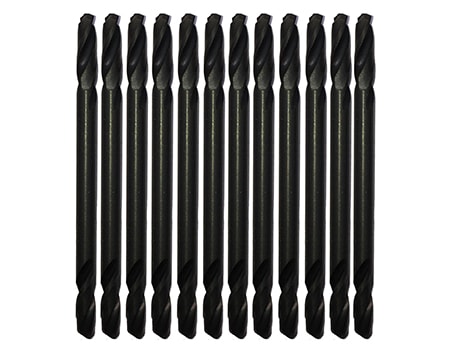
Unless you're on a a serious construction team, you've probably not used one of these. Rivet bits can drill out the small holes needed for rivets to secure two pieces of metal together. This is a specialized tool that many households won't ever have a need for.
Masonry Drill Bits
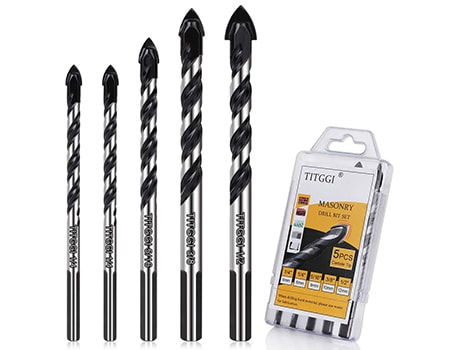
These are used commonly to drill into stones, brick, concrete, quarry tiles, blocks, etc. Typically, the cutting tip of the masonry bit is made of tungsten carbide, which is combined with a spiraled shaft made of steel.
Some types of masonry bits feature a silicon bronze alloy tip that is highly durable. While masonry bits are used mostly in power drills, you can also use them in hand braces.
The objective is to have sufficient power to ensure that the drill can go through hard concrete surfaces easily.
However, if you are using the bit for harder materials, then it is recommended to use the drill at a slower speed, which prevents overheating and also lets you stop to remove the debris lying around.
You can use a drill sharpener or a grindstone to sharpen the masonry types of drill bits.
Bullet Pilot Point Drill Bits
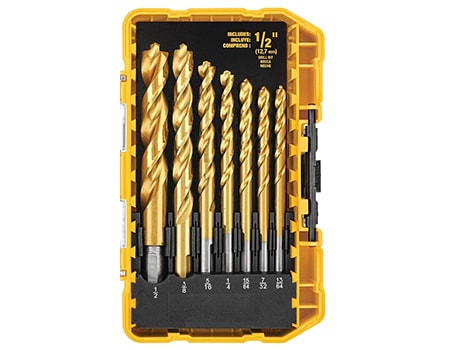
Commonly mistaken for a spur point bit, the bullet pilot point bit is perfect for use on wood, metal and plastics. These can be useful for removing stripped bolts, as an example. Just make sure the types of bolts you're drilling out are of a softer metal than the drill bit.
The bullet pilot point bit has twisted flutes, which are ground away, resulting in a more accurate drill bit compared to the regular twisted drill bits.
Bullet pilot point bits make cleaner holes and also cause less damage to the workpiece compared to other drilling bits.
Countersink Drill Bits
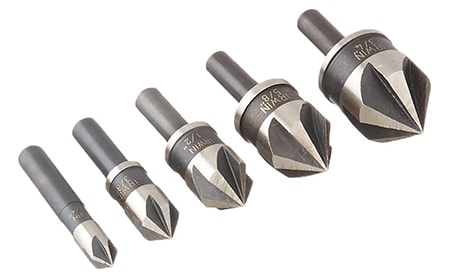
These bits are indispensable if you want to make conical recesses in the workpiece to install countersink screws. Countersink bits cannot be used on metals but they are designed for use on softer materials like wood and plastics.
Some of the bits come along with a handle, which lets you make the recess in the holes using a hand twisting motion.
You can also use the countersink bits along with a clearance drill as this combination allows you to drill a clearance hole and a countersink recess all at once. Combine them with a self-centering bit for the rest of the job and you'll have high accuracy.
Plug Cutting Drill Bits
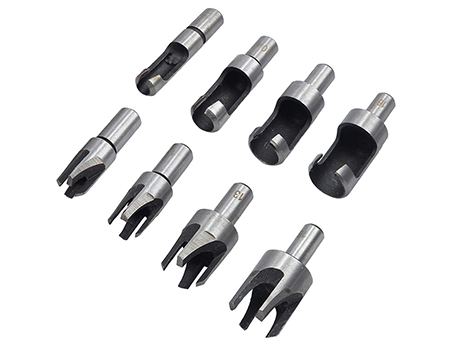
These are designed for precision tasks with the expectation of a beautiful outcome, like with cabinetry and installing the right types of cabinet hinges. What they do is simultaneously drill out a countersink hole for screws to reside in while also cutting out a plug of the exact same size as the countersink hole.
So once the screw is in place you can glue the plug in over the top of whatever types of screws you used and sand them or even align the wood grain to match to reduce visibility. This works with all types of wood grain patterns, though the coarser ones are harder to match perfectly.
Tile Drill Bits
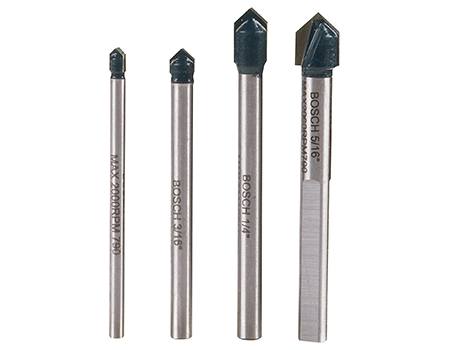
If you need to drill into glass or ceramic tiles, then you will require a tile bit. Tile bits usually come with tungsten carbide tips that let you make holes into tiles without cracking or chipping them.
There are different types of tile bits for different kinds of tiles and so you must check the kind of tile drill bit and ensure that it is the right type to drill into the tile. Some are called spear point bits and some diamond tile bits.
Usually, the tile bit should be used along with a power drill or hand drill at a low speed. When you’re using the tile bit to drill in glass, then it is a good idea to use a lubricant like turpentine or white spirit that will help to keep the tip of the bit cool.
You can use a masonry bit to drill into ceramic tiles; however, you should ensure that the power drill runs at the lowest speed, without any hammer action because the hammer action could end up splitting the tiles.
Flatwood Drill Bits
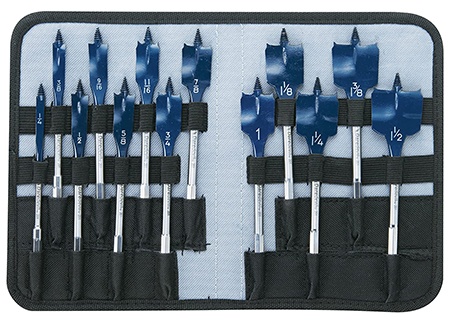
A flatwood bit, also called a spade bit or paddle bit, features a pointed center, which guides the flat portion in order to drill into the wood. Flatwood bits can be used only along with a power drill.
The side of the bit cuts away the wood and makes a hole. If you want to make large holes in the workpiece then using a flatwood bit is the best option.
And, because of the design of the bit, it will make a flat-bottomed hole in the workpiece.
You will need to use a power drill if you are using a large flatwood bit so that it can easily push it into the wood. The drill bit is very easy to sharpen using a grindstone, an oilstone or a fine file.
Installer Drill Bits
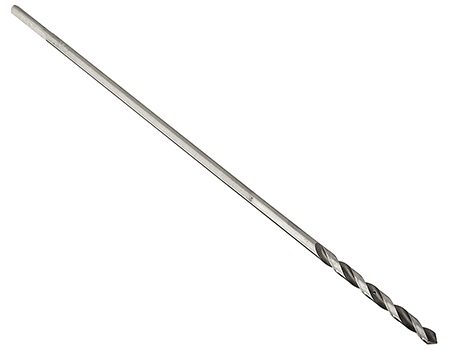
This is a specialized enough of the types of drill bits of the twist variety to warrant mentioning. These bits are made to be long, as much as 18 inches in length. They're designed to reach into deep crevices or drill through thick materials.
The core purpose is for to create holes to run wiring for speaker systems, security cameras, server rooms, and other such applications, without needing to create larger holes than needed. You can thread the thin cable through and then attach the jack after the fact, keeping the holes even smaller.
Spur Point Drill Bits
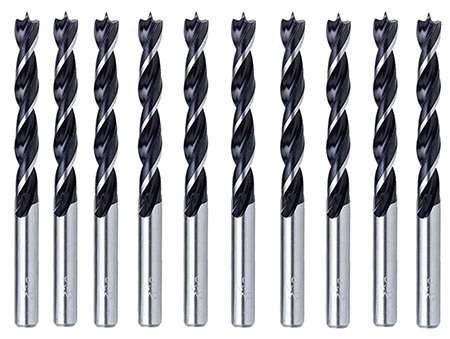
Also commonly called the dowel or wood bit, the spur point bit has a central point and 2 raised spurs on the sides. The 2 spurs help to ensure that the drill bit is in a straight position while drilling.
It is recommended to use the spur point bit with a power drill because it offers less resistance and produces smoother and cleaner holes. Spur point bits are best for drilling wood and plastics.
The drill bits are equipped with a depth stop that allows you to select the required depth of the hole that you are drilling.
The central point and the spurs of the drill bit can be sharpened using a fine file. And, ensure that the angle between the central point and spurs is 90 degrees.
Hole Saw Bit
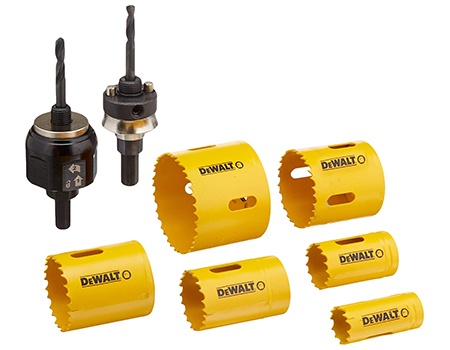
A hole saw bit is a good option if you want to make large holes in plastic, wood, masonry, or metal. These are versatile, multi-purpose bits that can be used for the purpose of building, repairs and renovations.
Hole saw bits can typically cut to a depth of around 18 mm and if you want to get a smoother hole, then you can use the bit along with a power drill operated at very slow speeds.
Once you have your collection of different drill bits together, you'll want to take note of our article on how to remove rust from tools so you can keep them in pristine shape for the foreseeable future.
Self-Feed Drill Bit
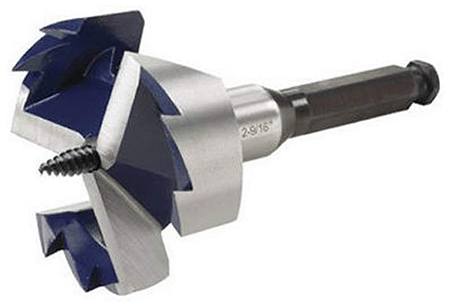
This type of bit is similar to a hole saw bit but, like a paddle bit, there's no need to drill all the way through the material. This allows you to create circular indentations with flat bottoms rather than holes.
The bit features a central tip to guide and keep your work stationary. The outer ring also pre-cuts a circumference before a horizontal blade shaves the inner surface area of the circle out.
Forstner Drill Bits
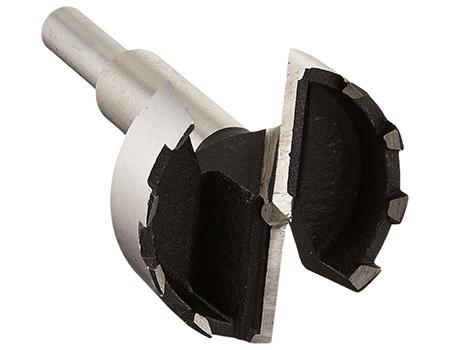
Forstner drill bits are specialized bits featuring a flat bottom and are commonly used on wood such as cupboard hinges, woodworking, and other building projects.
They are capable of drilling large holes and the flat base ensures that you can stop before the bit goes through the wood.
The flat base also ensures that you get clean holes and the Forstner drill bit works better with a power drill rather than a handheld drill.
Using a freehand motion can make it difficult to position the bit and control it. Forstner drill bits come in two types—with a saw-tooth rim and continuous rim.
The drill bit with the continuous rim produces clean-edged holes and is ideal for small holes, while the saw-tooth rim bit produces rather rough holes and is ideal for larger-sized holes and also lasts much longer.
Wood Auger Drill Bit
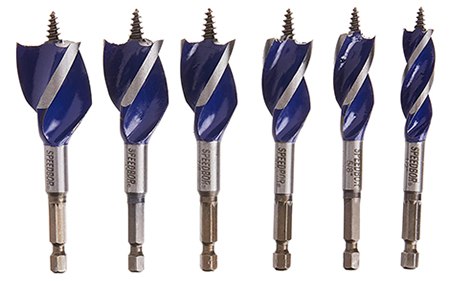
Auger drill bits can drill very large holes very easily in thick, dry hardwood and boards. The auger drill bit features a screw thread at its tip, which helps to draw the bit into the material and the cutting edge produces a smoother finish by scribing the hole’s circumference.
The drill bit has large flutes that help to remove the wood chips quickly. Auger drill bits are used commonly in a hand brace and produce deep, clean holes with a flat bottom. You can use a fine file to sharpen the auger drill bit.
Step Drill Bits
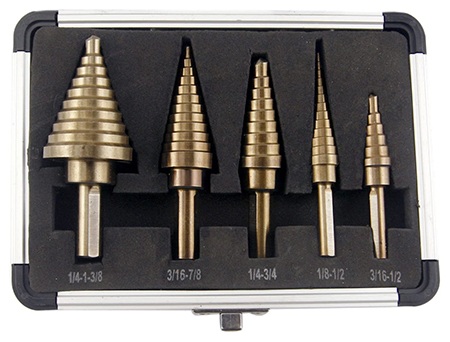
The stair-like design of this drill bit gives the step drill bit its name. The bit has a conical design that allows you to drill holes of different sizes on sheet metal. It's the most unique of the drill bit shapes, for sure.
If you want to make holes in thin or soft materials, then a step drill bit is ideal. It can also be used to enlarge holes that have been made already or for the purpose of light deburring.
Generally, step drill bits have a coating of titanium nitride that helps to reduce the heat buildup and this also helps to keep the drill bit lubricated. The step drill bit is very versatile; but quite pricey too.
Core Drill Bit
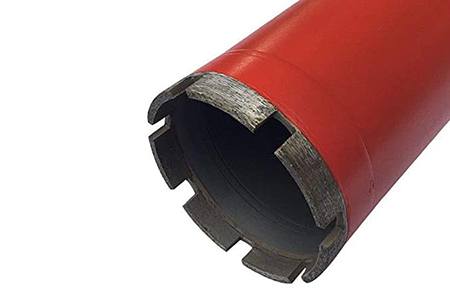
These are often called an "annular cutter". They drill out a deep circle from the material you're working on, but in such a way that the core plug can then be removed from the drill bit. This core can then be used for any other purpose you have in mind.
Diamond Drill Bits
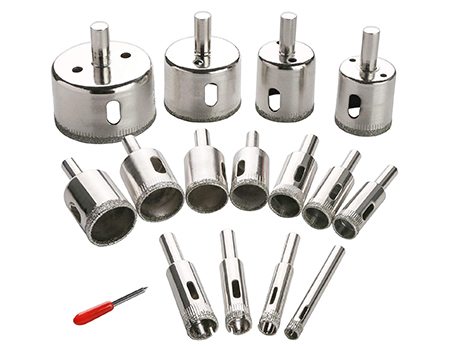
Diamond drill bits are treated at the tips, not with diamond, but with industrial grade carbon steel that's finely shredded. This steel is then coated with nickel to help resist corrosion. This creates a lot of fine sharp edges to chew through whatever material you throw them at.
They're used on materials like glass, tiles, ceramics, marble, granite, stones, and all kinds of harder surfaces that a softer drill bit may not work with. You need to lubricate these with water as you're drilling, by the way.
Types of Drill Bits for Every Material & Need
If you need to drill holes in different materials, then we are sure that with this information, you will have a fair idea of which drill bit to use depending on the material you are working on.
And, if you generally work on different projects and different materials, then it is a good idea to get a drill bit set with as many different types of drill bits as possible.



